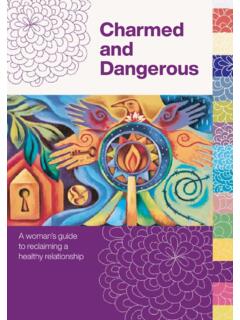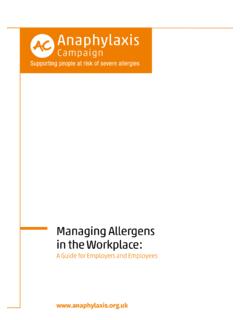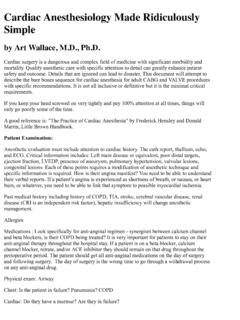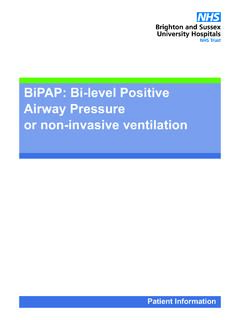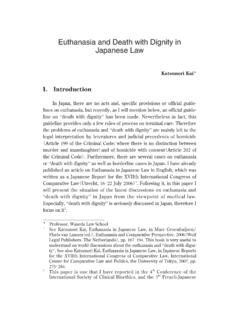Transcription of EMERGENCY PROTOCOL SCENARIOS
1 EMERGENCY PROTOCOL SCENARIOS American Association of Orthodontists Robert D. Elliott, DMD, MS Copyright Pedo Springboard 2014 2 TABLE OF CONTENTS I. List of Medications Page 3 II. Basic EMERGENCY Equipment Page 5 III. EMERGENCY Team Page 6 IV. Emergencies and Their Management Page 8 Syncope Page 9 Allergic Reactions Page 10 Hypoglycemia/ Insulin Shock Page 12 Convulsions Seizures Page 13 Bronchospasm (Asthma) Page 14 Vomiting, Aspiration & Choking Page 15 Hypotension Page 16 Angina Pectoris (chest pain) Page 17 Myocardial Infarction & Cardiac Arrest Page 18 Hyperventilation Page 19 V. Sample Check List Forms Page 21 VI. Employee Compliance Signature Log Page 25 VII. Vital Signs Recording Sheet Page 27 VIII. EMERGENCY Fire Exit Plan Page 28 Copyright Pedo Springboard 2014 3 I. LIST OF MEDICATIONS ALBUTEROL (VENTOLIN/PROVENTIL) bronchodilator Inhaler, for asthma attacks ANTIHYPOGLYCEMICS (cake icing, Coca-cola, sugar) For unexplained unconsciousness and seizures of unknown origins Glucagon, orange juice, cake icing AMMONIA INHALANT Syncope Crushed between fingers and placed under nose ATROPINE (anticholinergic agent, anti-asthmatic, bronchodilator) Bradycardia Bronchospasms Dosage.
2 02 mg/kg every 5 minutes BENADRYL (DIPHENHYDRAMINE) histamine blocker For delayed allergic reactions Dosage: Adult: 50mg injected IM (deep) Child: 25mg injected IM (deep) Oral Dosage: <6 yrs: 1 teaspoon ( mg) 6-12 yrs: 2 teaspoons (25 mg) >12 yrs: 4 teaspoons (50 mg) Copyright Pedo Springboard 2014 4 DEXAMETHASONE (steroid) Treat airway edema (Severe Allergic Reactions, Anaphylaxis) Dosage: . mg/kg/day EPINEPHRINE 1:1000 - bronchodilator For acute allergic reactions, asthma attacks, bradycardia and cardiac arrest Delivered by injector stick (pre-loaded syringes 2-3 x 1ml) Dosage: Adult: - mg/kg Child: .01 mg/kg NITROGLYCERINE - vasodilator For chest pain of angina pectoris Dosage: .4mg tablets (sublingual) or .4mg/spray Note: tablets will only have a 12 day shelf life once exposed to light and air OXYGEN E cylinder delivery tanks to aid in breathing difficulties or as blow by Copyright Pedo Springboard 2014 5 II.
3 BASIC EMERGENCY EQUIPMENT OXYGEN DELIVERY SYSTEM Delivers positive pressure oxygen Must maintain a patent airway Must have an airtight seal of mask on face Various sizes of masks SUCTION SYSTEM AND TIPS Tips need to be large diameter and rounded to suction vomitus and blood (high vacuum suction) Manual suction if power goes out AED (portable pulse oximeter recommended) BLOOD PRESSURE CUFF AND STETHOSCOPE Crash Cart Supplies: Copyright Pedo Springboard 2014 6 III. EMERGENCY TEAM DR. _____ Performs basic life support Administers medications FIRST CLINICAL ASSISTANT Notifies TWO other assistants for help Gets EMERGENCY kit Passes drugs and equipment Helps administer basic life support Ventilates patient SECOND CLINICAL ASSISTANT Calls 911 STAY ON THE PHONE States the MEDICAL EMERGENCY (ie: Respiratory Depression ) States This is a DENTAL office, not a medical office there is NO physician present!
4 THIRD CLINICAL ASSISTANT Monitors vital signs Record keeping use Vital Signs Recording sheet FOURTH CLINICAL ASSISTANT Calls Admin via intercom and informs of EMERGENCY /situation - CODE BLUE! Admin team member will go outside and wait for EMS to arrive Make sure EMS is escorted to office and room where EMERGENCY is being managed Copyright Pedo Springboard 2014 7 EMERGENCY ROAD MAP R ecognition Unconsciousness Altered consciousness Respiratory difficulty Seizure Drug related EMERGENCY Chest pain 1. Discontinue treatment 2. Assess level of consciousness 3. Position patient accordingly 4. Suction if needed A ssess Consciousness 1. ALERT is patient aware of surroundings? 2. VERBAL can patient respond to questions? 3. PAIN does patient react to peripheral pain? 4. UNRESPONSIVE to verbal command or pain CALL 911! P osition - If Unconscious: 1. Place patient in supine position 2.
5 Elevate feet slightly above head 3. P-CAB s if needed R eassess patient Copyright Pedo Springboard 2014 8 IV. EMERGENCIES AND THEIR MANAGEMENT TABLE OF CONTENTS Syncope Page 9 Allergic Reactions Page 10 Hypoglycemia/ Insulin Shock Page 12 Convulsions Seizures Page 13 Bronchospasm (Asthma) Page 14 Vomiting, Aspiration & Choking Page 15 Hypotension Page 16 Angina Pectoris (chest pain) Page 17 Myocardial Infarction & Cardiac Arrest Page 18 Hyperventilation Page 19 Copyright Pedo Springboard 2014 9 SYNCOPE 50% of all dental emergencies produced by a sudden drop in blood pressure which decreases oxygen supply to brain. Dizziness associate with fainting Patient feels warm, is pale, sweaty, nauseous and tachycardic Patient may feel nauseous for next 24 hours MANAGEMENT 1. Position patient in supine position 2. Elevate legs 3. Administer oxygen 1.
6 Administer ammonia inhalant If no recovery in SECONDS, call 911! 5. Observe for one hour should not leave office alone Copyright Pedo Springboard 2014 10 ALLERGIC REACTIONS A hypersensitive state acquired through exposure to an allergen or re-exposure that produces a heightened capacity to react. Reactions can be mild, delayed (up to 48 hrs.), immediate and/or life threatening 15% of all adverse drug reactions are immunologic or true allergies N20/02 has never been known to elicit an allergic response A good thorough history is crucial! TYPES OF RESPONSES: SKIN REACTIONS symptoms include urticaria (smooth, elevated patches of skin with itchiness), erythema and angioedema RESPIRATORY REACTIONS symptoms include bronchospasm, local edema of larynx leading to airway obstruction ANAPHYLAXIS the most acute and life threatening! Death can occur in minutes! Patient symptoms include nausea, itchiness, flushing, hives on face and chest, vomiting, cramps.
7 Respiratory symptoms then follow tightness in chest, coughing, wheezing. Cardiovascular symptoms follow pallor, light headiness, palpitations, tachycardia, hypotension, arrhythmias, loss of consciousness, and finally cardiac arrest. This is known as anaphylactic shock. Copyright Pedo Springboard 2014 11 SKIN REACTIONS 1. Administer an antihistamine or benadryl a. Child under 6yo: to 1 tsp ( per tsp) b. Child (6-12 yrs): 1-2tsp ( per tsp) c. Child over 12 - Adult (>60kg): 2-4 tsp ( per tsp) 2. Continue with oral benadryl for 3-5 days prescribed before leaving 3. Refer to an allergist/consult with a physician If severe reaction: 1. Epinephrine IM or SC Note: onset of action for IM is 10 minutes (peaks at 30 min); oral takes 60 minutes and is not effective 2. Call 911 or have medical consultation before discharge RESPIRATORY REACTIONS 1. Refer to Bronchospasm section 2.
8 Laryngeal Edema a. place patient in supine position and elevate legs b. administer epinephrine IM from preloaded syringe mg/kg ADULT mg/kg CHILD (up to .3mg) c. maintain patent airway GENERALIZED ANAPHYLAXIS 1. Call 911 2. Supine position 3. Institute BLS a. monitor and record vital signs b. administer O2 c. CPR 4. Administer epinephrine 1:1000 concentration sub Q mg/kg ADULT .01 mg/kg CHILD 5. Administer benadryl (diphenhydramine) IM in front of upper leg 50mg ADULT 25mg CHILD (approx. 1cc) 6. Should see resolution in minutes 7. Administer second dose, if necessary 8. When stable, give benadryl IM in front of upper leg to decrease chance of recurrence 9. Contact MD for consultation of admission to hospital for monitoring Copyright Pedo Springboard 2014 12 HYPOGLYCEMIA / INSULIN SHOCK Low blood sugar Associated with Type I Diabetes (Insulin Dependent Diabetes Mellitus) Will see mental confusion, mild muscle tremor, diaphoresis, cold feeling and tachycardia Usually seen when patient doesn t eat prior to appointment If patient must be fasting then insulin should be adjusted per physician If blood sugar falls too low, seizures and loss of consciousness follow MANAGEMENT 1.
9 End procedure 2. Make patient comfortable 3. Check blood glucose (<60 is a problem for a child) Infant normal 50-80 mg/dL Child 1-16yo 60-100 mg/dL >16yo normal 74-106 mg/dL 4. Give patient sugar (cake icing, orange juice, candy) 4. Maintain patent airway 5. Check and record vitals: Blood pressure Respiration rate Pulse INSULIN SHOCK If unconscious: 2. call 911 3. Administer 100% oxygen 4. Administer cake icing mucosally by placing under maxillary lip and continue oxygen delivery 5. Alternatively administer 50% Dextrose intravenously Copyright Pedo Springboard 2014 13 CONVULSIONS - SEIZURES Seen commonly in epileptics but can be elicited by stress, overdose of local anesthetic or intravascular injection of local anesthetic. Usually associated with hyperventilation, hypoxia, anoxia, and hypercarbia Patient requires adequate ventilation Most seizures last 2-5 minutes MANAGEMENT 1.
10 End procedure 2. Call 911 3. Position patient in supine position 4. Gently hold patient s arms and legs to prevent injury (allow controlled movement) 5. Do not place anything in patient s mouth 6. Keep airway patent 1. Administer 100% oxygen 2. Maintain A, B, C s! 3. Consider benzodiazepine Valium dose (max 10mg) or Versed dose (max 20mg) Note: Morbidity and mortality can occur post seizure! Copyright Pedo Springboard 2014 14 BRONCHOSPASM (asthmatic attack) A constriction of smooth bronchial muscle causing respiratory distress, dyspnea, wheezing, flushing, cyanosis, perspiration, tachycardia, and anxiety There is a higher percentage of bronchospasm noted in children! MANAGEMENT 1. End Treatment immediately 2. Position patient in semi-erect position 3. Monitor with pulse oximeter 4. Initiate bronchodilation: a. albuterol via inhaler first! b.

